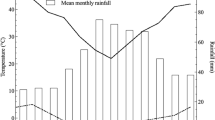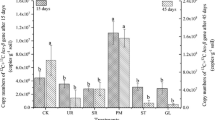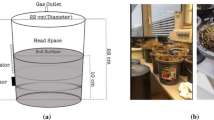Abstract
Knowledge of isotopic discrimination, or fractionation, by denitrifying bacteria can benefit agricultural fertilizer management, wastewater treatment, and other applications. However, the complexity of N transformation pathways in the environment and the sensitivity of denitrification to environmental conditions warrant better isotopic distinction between denitrification and other processes, especially for oxygen isotopes. Here, we present a dataset of δ18O measurements in continuous culture of Paracoccus denitrificans. The authors hope that it will be useful in further studies of N2O in the environment.


Similar content being viewed by others
References
Myhre G, Shindell D, Bréon F-M, et al (2013) Anthropogenic and natural radiative forcing. Clim Chang 2013 Phys Sci Basis Contrib Work Gr I to Fifth Assess. Rep Intergov Panel Clim Chang :659–740. doi: 10.1017/CBO9781107415324.018
Sigman D, Karsh K, Casciotti K (2009) Ocean process tracers: nitrogen isotopes in the ocean. Encycl Ocean Sci :4138–4153.
Kool DM, Dolfing J, Wrage N, Van Groenigen JW (2011) Nitrifier denitrification as a distinct and significant source of nitrous oxide from soil. Soil Biol. Biochem. 43:174–178. doi:10.1016/j.soilbio.2010.09.030
Snider DM, Venkiteswaran JJ, Schiff SL, Spoelstra J (2013) A new mechanistic model of δ18O-N2O formation by denitrification. Geochim. Cosmochim. Acta 112:102–115. doi:10.1016/j.gca.2013.03.003
Martin TS, Casciotti KL (2016) Nitrogen and oxygen isotopic fractionation during microbial nitrite reduction. Limnol. Oceanogr. 61:1134–1143. doi:10.1002/lno.10278
Michener RH, Lajtha K (2007) Stable isotopes in ecology and environmental science. Ecol methods concepts Ser. doi:10.1899/0887-3593-028.002.0516
Barford CC, Montoya JP, Altabet MA, Mitchell R (1999) Steady-state nitrogen isotope effects of N2 and N2O production in Paracoccus denitrificans. Appl. Environ. Microbiol. 65:989–994
Goericke R, Montoya JP, Fry B (1994) Physiology of isotope fractionation in algae and cyanobacteria. In: Lajtha K, Michener R (eds) Stable isototopes Ecol. Environ. Sci, 1st edn. Blackwell Scientific Publications, Cambridge, pp. 187–221
Mariotti A, Germon JC, Hubert P, et al (1981) Experimental determination of nitrogen kinetic isotope fractionation: some principles; illustration for the denitrification and nitrification processes. Plant Soil 62:413–430. doi:10.1007/BF02374138
Snider DM, Schiff SL, Spoelstra J (2009) 15N/14N and 18O/16O stable isotope ratios of nitrous oxide produced during denitrification in temperate forest soils. Geochim. Cosmochim. Acta 73:877–888. doi:10.1016/j.gca.2008.11.004
Kaspar HF, Tiedje JM (1980) Response of electron-capture detector to hydrogen, oxygen, nitrogen, carbon dioxide, nitric oxide and nitrous oxide. J. Chromatogr. A 193:142–147
Yoshinari T, Altabet MA, Naqvi SWA, et al (1997) Nitrogen and oxygen isotopic composition of N2O from suboxic waters of the eastern tropical north pacific and the Arabian Sea—measurement by continuous-flow isotope-ratio monitoring. Mar. Chem. 56:253–264. doi:10.1016/S0304-4203(96)00073-4
Sigman DM, Casciotti KL, Andreani M, et al (2001) A bacterial method for the nitrogen isotopic analysis of nitrate in seawater and freshwater. Anal. Chem. 73:4145–4153. doi:10.1021/ac010088e
Kroopnick P, Craig H (1972) Atmospheric oxygen: isotopic composition and solubility fractionation. Science 175(80):54–55. doi:10.1126/science.175.4017.54
Wunderlich A, Meckenstock RU, Einsiedl F (2013) A mixture of nitrite-oxidizing and denitrifying microorganisms affects the δ18O of dissolved nitrate during anaerobic microbial denitrification depending on the δ18O of ambient water. Geochim. Cosmochim. Acta 119:31–45. doi:10.1016/j.gca.2013.05.028
Author information
Authors and Affiliations
Corresponding author
Electronic Supplementary Material
Online Resource 1
This spreadsheet file gives the measured δ18O of N2O from six chemostat runs. Data shown are the fraction of NO3− consumed at steady state, and the δ18O of N2O relative to two common standards (SMOW and atmospheric O2). The number of days elapsed between sample collection and cryogenic distillation are also shown. (XLSX 32 kb)
Rights and permissions
About this article
Cite this article
Barford, C., Montoya, J., Altabet, M. et al. Steady-State Oxygen Isotope Effects of N2O Production in Paracoccus denitrificans . Microb Ecol 74, 507–509 (2017). https://doi.org/10.1007/s00248-017-0965-3
Received:
Accepted:
Published:
Issue Date:
DOI: https://doi.org/10.1007/s00248-017-0965-3




